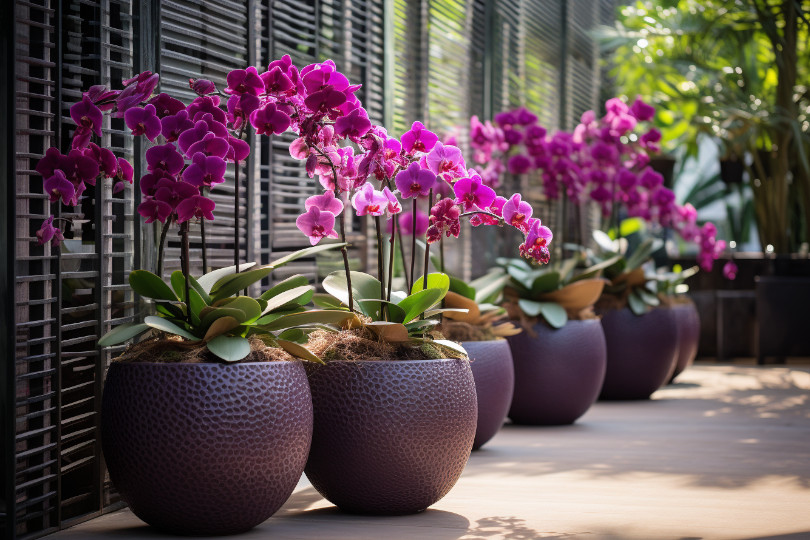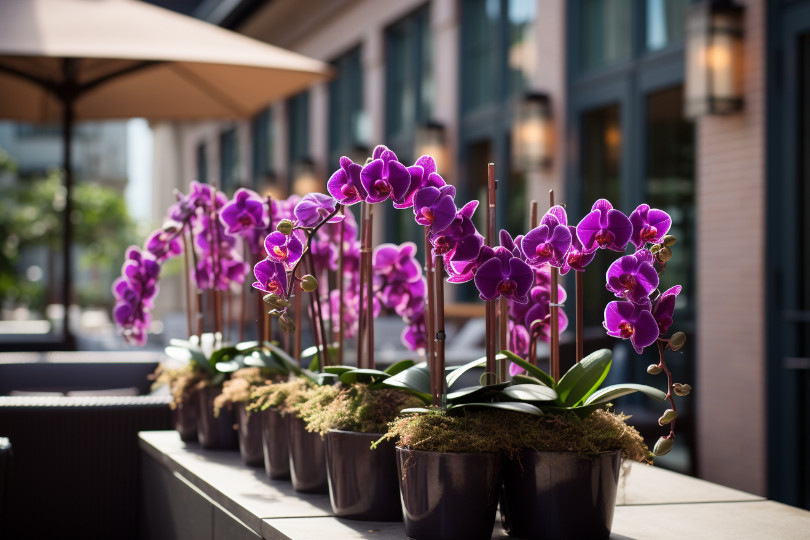Purple orchids are some of the world’s most stunning and unique flowers. Their vibrant colors and intricate patterns have captivated people for centuries. Whether grown in gardens or displayed in floral arrangements, purple orchids add a touch of elegance and beauty to any setting. This post aims to delve into the captivating realm of purple orchids, covering their diverse types, ways to care for them, and significance. Join us as we delve into the enchanting world of these extraordinary flowers.
Table of Contents
The significance and symbolism of purple orchids



Purple orchids hold significant symbolism in various cultures and traditions across the world. Their rich and royal color is often associated with luxury, wealth, and power. In ancient Greece, purple orchids were considered symbols of strength and masculinity, while in Chinese culture, they are believed to represent fertility and abundance.
Aside from their cultural symbolism, purple orchids also have deep emotional connotations. They are associated with admiration, dignity, and respect. These elegant flowers are often given as gifts to express affection and convey a sense of elegance and dignity. In the language of flowers, the purple orchid also symbolizes rare and delicate beauty.
Types of purple orchids and their characteristics
Purple orchids come in various varieties, each with unique characteristics and allure. Let’s delve into some of the most stunning types of purple orchids and uncover their captivating features.
1. Phalaenopsis (Moth Orchid): Known for its large, showy blooms, Phalaenopsis orchids are popular among orchid enthusiasts. They feature vibrant purple petals that often have faint patterns or speckles, adding an element of intrigue to their already striking appearance.
2. Cattleya (Corsage Orchid): Cattleya orchids are renowned for their vibrant colors and intoxicating fragrance. They boast bold purple blooms with velvety petals that exude elegance and charm.
3. Dendrobium: Dendrobium orchids are known for their graceful and delicate blooms. They come in shades of purple, ranging from deep and royal to soft and lavender.
4. Vanda: With their stunning purple hues and enchanting scent, Vanda orchids are a sight. These vibrant flowers feature broad, flat petals, making them stand out in any floral arrangement.
Caring tips and tricks.
Now that we’ve explored the captivating beauty of different types of purple orchids let’s shift our focus to the essential aspects of caring for these mesmerizing flowers.
1. Lighting: Bright, indirect light is ideal for the growth of purple orchids. It is best to position them near a window that receives filtered sunlight. However, it is essential to avoid exposing them to direct sunlight, as it can cause harm to the delicate petals.
2. Temperature and Humidity: Most purple orchids prefer temperatures between 65-80°F (18-27°C) during the day and slightly cooler temperatures at night. Higher humidity levels benefit orchids and can be attained by placing a tray of water close to the orchid or using a humidifier.
3. Watering: Find a balance between keeping the orchid’s root system moist and avoiding overwatering, which can lead to root rot. Water your purple orchid once a week, allowing the top layer of soil to dry before next watering.
4. Fertilization: During the growing season, providing your purple orchid with a well-balanced orchid fertilizer every 2-3 weeks is essential. Following the manufacturer’s dosage and application instructions is recommended for optimum results.
5. Repotting: Repot your orchid in a slightly larger pot with fresh orchid-specific potting medium. Do this when the plant is not blooming, typically every 2-3 years, to refresh the growing environment and give the roots space to grow.
By providing the right conditions, you can enjoy the beauty of purple orchids for an extended period. Read in detail about potting mix for orchids.
The popularity and demand in the market
Purple orchids have gained immense popularity amongst both flower enthusiasts and casual buyers. Their unique color and elegant appearance make them a top choice for various occasions such as weddings, anniversaries, and even corporate events. Moreover, the exotic nature of these blooms adds elegance to any floral arrangement.
The high demand for purple orchids has led to an increase in their availability in the market. Nurseries and flower shops now offer a wide range of purple orchid varieties, making it easier for individuals to find and purchase these coveted flowers.
In addition to their aesthetic appeal, purple orchids also hold symbolic meanings. They are often associated with luxury, elegance, and even love. This has further contributed to their growing popularity as a gift choice for special occasions.
With the increasing interest in purple orchids, breeders and enthusiasts have also been working on creating new hybrids and cultivars, resulting in many exciting options for those wishing to add this stunning flower to their collection.
Common challenges in growing and maintaining purple orchids
Developing and maintaining purple orchids can be a rewarding yet challenging endeavor. Like any other plant, purple orchids require specific care and attention to ensure their health and longevity.
One common challenge in growing purple orchids is providing the right amount of light. Direct sunlight can harm their delicate blooms, requiring bright, indirect light. Finding the perfect balance is crucial to maintaining their vibrant purple color.
Another challenge is achieving the proper humidity levels. Purple orchids thrive in humid environments, and lack of moisture can cause their leaves to become dry and brittle. However, excessive humidity can lead to root rot and fungal diseases. Monitoring the humidity levels and providing proper ventilation to prevent these issues is essential.
Proper watering is also essential for the well-being of purple orchids. Overwatering the orchid plants can cause the roots to rot, while underwatering can cause dehydration and wilting. Finding the proper watering schedule and ensuring good drainage is vital to their survival.
Lastly, pests and diseases can pose a threat to purple orchids. Common pests include aphids, mealybugs, and spider mites, which can weaken the plant and damage the flowers. Regular inspections and prompt treatment are crucial to prevent infestations and diseases from spreading.
Conclusion: the beauty and allure of purple orchids
Despite the challenges of growing and maintaining purple orchids, their beauty and allure make it all worthwhile. These exquisite flowers have captivated the hearts of many with their vibrant purple hues and unique shapes.
You can successfully cultivate and enjoy these remarkable plants in your home or garden with the proper care and attention. By providing the appropriate amount of light, humidity, and watering, you can ensure the health and longevity of these flowers.
Staying vigilant against pests and diseases is essential to protect your orchids from harm. Regular inspections and proactive treatment can prevent infestations and keep your plants thriving.
The following section will delve into effective techniques and tips for overcoming these challenges and achieving success in growing and maintaining purple orchids. Join us as we explore the secrets to flourishing orchids and unlock the full potential of these mesmerizing flowers. Stay tuned!

